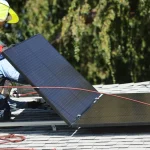Sustainable and Green Financing Options for Eco-Conscious Borrowers
Let’s be honest. For a long time, “green living” and “financing” felt like they existed on different planets. One was all about idealism and saving the planet; the other, well, was about cold, hard cash. But that gap? It’s closing. Fast.
Today, a powerful shift is happening. Lenders are finally catching up to a growing demand from borrowers who want their money to reflect their values. If you’re looking to fund a solar panel installation, an energy-efficient car, or even a greener home renovation, there are now real, tangible options. This isn’t just about getting a loan—it’s about making your financial footprint as light as your environmental one.
What Exactly is Green Financing?
In a nutshell, green financing is any loan, mortgage, or line of credit specifically designed to fund environmentally friendly projects or purchases. Think of it as a targeted tool. Instead of a general personal loan you could use for anything, these products are built with a green purpose in mind. The lender often partners with energy auditors or has a specific list of qualifying eco-upgrades.
The best part? They frequently come with benefits that make them more attractive than standard loans, like slightly lower interest rates or longer repayment terms. It’s the financial world’s way of saying, “We support what you’re doing.”
Your Toolkit: Types of Green Loans and Mortgages
Okay, so what’s actually out there? The menu of sustainable financing options is more diverse than you might think. Here’s a breakdown of the most common ones.
1. Energy-Efficient Mortgages (EEMs)
An EEM is arguably the heavyweight champion of green home financing. It allows you to roll the cost of energy-efficient improvements right into your mortgage when you buy a home—or refinance one. Maybe the house you’re buying has an ancient, groaning HVAC system. With an EEM, you can borrow a little extra to replace it with a top-tier efficient model without needing a separate loan.
The logic is brilliant: the money you save on future utility bills can help offset the slightly higher mortgage payment. It’s a win-win.
2. PACE Financing
Property Assessed Clean Energy (PACE) programs are a unique animal. They’re offered by local governments and are repaid through an assessment on your property tax bill over a long term, often 10-20 years. The huge advantage? The obligation is tied to the property itself, not you personally. If you sell the house, the repayment responsibility typically transfers to the new owner.
The catch? They’re not available everywhere, and you absolutely need a rock-solid understanding of the terms.
3. Green Auto Loans
You see these more and more from credit unions and some forward-thinking banks. These auto loans offer a reduced interest rate for purchasing a new or used hybrid or electric vehicle (EV). It might only be a percentage point or so, but hey, every bit counts—both for your wallet and for the planet.
4. Eco-Friendly Personal Loans
These are unsecured loans offered by online lenders, green banks, and credit unions explicitly for sustainable projects. Need $15,000 for a new solar array? This is your go-to. The application process is usually quick, and the funds can be in your account within days. They’re perfect for discrete projects that don’t involve real estate.
Navigating the Application Process: What to Expect
Applying for green financing isn’t all that different from a standard loan, but there are a few key nuances.
Eligibility and Qualifications: Your credit score and debt-to-income ratio are still king. Lenders need to know you’re a good risk. But for projects like EEMs, you might also need a home energy assessment to prove the upgrades will actually save energy. It’s not just a formality; it’s what justifies the “green” label.
The Devil’s in the Details: You have to read the fine print. What exactly qualifies? Does “green home improvement” include drought-resistant landscaping, or only HVAC and insulation? Some programs have very specific lists of approved contractors and equipment. Do your homework upfront to avoid frustration later.
Greenwashing: How to Spot a Truly Sustainable Lender
Let’s not be naive. As “green” becomes a powerful marketing term, some lenders will try to use it without the substance to back it up. This is, you know, classic greenwashing.
How can you tell the real deal from a poser? Look for transparency. A genuine green lender will:
- Clearly define what projects qualify for their loans.
- Often provide educational resources about energy savings and sustainability.
- Perhaps even report on the aggregate environmental impact of their loan portfolio. Do they talk about the total tons of CO2 their customers have saved? That’s a great sign.
Don’t be afraid to ask pointed questions. Their answers will tell you everything.
The Ripple Effect: Why Your Choice Matters
Choosing a green loan does more than just get your project funded. It sends a powerful market signal. Every time someone opts for sustainable financing, it tells the financial industry that there is a real, growing demand for ethical lending products. This encourages more banks to develop their own programs, creating a positive feedback loop that makes green options more accessible and affordable for everyone.
Your individual choice becomes part of a collective push toward a more sustainable economy. It’s voting with your dollar—or in this case, your debt—for the world you want to live in.
So, the next time you’re considering a loan, look beyond the interest rate. Look at its purpose. Because the right financing can do more than just build a project; it can help build a better future.





